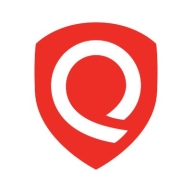


Morphisec and Qualys CSAM both operate in the cybersecurity space, focusing on endpoint protection and asset management, respectively. Morphisec is distinguished by its strong threat prevention capabilities, while Qualys CSAM leads in comprehensive asset visibility and management.
Features: Morphisec offers seamless integration with Microsoft Defender, allowing for combined security event visibility on a single dashboard. It specializes in zero-day attack protection without relying on threat signatures, ensuring a lightweight operation. It also provides deterministic prevention for peace of mind with fewer false positives. Qualys CSAM provides extensive asset visibility and detailed risk identification, alongside external attack surface management and continuous monitoring. It also integrates well with CMDB and third-party platforms.
Room for Improvement: Morphisec could improve by enhancing communication around updates, network discovery capabilities, and reporting. Users also request a simpler licensing model and better integration capabilities. Qualys CSAM needs improvements in its user interface design, reporting analytics, and dynamic tagging. Optimization of integration with third-party tools and a simpler setup process are necessary, along with reducing costs for smaller businesses.
Ease of Deployment and Customer Service: Morphisec is known for its easy deployment in public and hybrid clouds, with silent operations. Despite responsive support, time zone challenges can arise. Qualys CSAM supports diverse cloud environments and offers strong technical support, yet faces complexities in integration and deployment. Morphisec excels in customer engagement, while Qualys sometimes requires prolonged coordination during initial setup.
Pricing and ROI: Morphisec is viewed as cost-effective, with competitive pricing offering substantial ROI through reduced management needs and a flat-rate model. In contrast, Qualys CSAM is seen as expensive, especially as a VMDR add-on, which can deter smaller enterprises. Although its asset management features are valued, more flexible pricing could enhance its appeal.
| Product | Market Share (%) |
|---|---|
| Qualys CyberSecurity Asset Management | 1.3% |
| Zafran Security | 1.1% |
| Morphisec | 0.5% |
| Other | 97.1% |


| Company Size | Count |
|---|---|
| Small Business | 5 |
| Midsize Enterprise | 8 |
| Large Enterprise | 8 |
| Company Size | Count |
|---|---|
| Small Business | 8 |
| Midsize Enterprise | 2 |
| Large Enterprise | 23 |
Zafran Security integrates with existing security tools to identify and mitigate vulnerabilities effectively, proving that most critical vulnerabilities are not exploitable, optimizing threat management.
Zafran Security introduces an innovative operating model for managing security threats and vulnerabilities. By leveraging the threat exposure management platform, it pinpoints and prioritizes exploitable vulnerabilities, reducing risk through immediate remediation. This platform enhances your hybrid cloud security by normalizing vulnerability signals and integrating specific IT context data, such as CVE runtime presence and internet asset reachability, into its analysis. No longer reliant on patch windows, Zafran Security allows you to manage risks actively.
What are the key features of Zafran Security?
What benefits can users expect from Zafran Security?
In industries where security is paramount, such as finance and healthcare, Zafran Security provides invaluable protection by ensuring that only exploitable vulnerabilities are addressed. It allows entities to maintain robust security measures while allocating resources efficiently, fitting seamlessly into existing security strategies.
Morphisec integrates seamlessly with platforms like Microsoft Defender, offering signatureless protection against zero-day threats and ransomware. It enhances existing endpoint solutions with minimal maintenance through its set-and-forget deployment, providing heightened security and reduced false positives.
Morphisec strengthens defense strategies by merging memory morphing and signatureless protection to effectively block zero-day attacks and ransomware. It operates efficiently within existing infrastructure, reducing system impact and maintenance needs. Users find its full visibility dashboard invaluable. Despite its strengths, cloud deployment and reporting features can be improved. Stability, alerts, and integration with other systems pose challenges for users, impacting usability and support quality.
What are Morphisec's key features?
What benefits should users consider in reviews?
In security-focused industries, Morphisec is crucial for protecting workstations and servers against sophisticated attacks like ransomware. Its signatureless technology offers early threat detection, while compatibility with existing systems ensures seamless integration, providing advanced protection without additional licensing costs.
Qualys CyberSecurity Asset Management provides advanced real-time asset visibility, dynamic tagging, and External Attack Surface Management. It streamlines asset discovery and management using cloud agents and IP-based scanning, enhancing risk management and software lifecycle tracking.
Qualys CyberSecurity Asset Management offers a comprehensive solution for managing asset inventories and tracking software lifecycle states. It facilitates network visibility and supports zero-day vulnerability solutions, enhancing security posture through efficient monitoring. Users benefit from its cloud-based interface, which provides in-depth asset configurations and insights. Key features include automated vulnerability scanning and unauthorized software management, reducing manual efforts. The platform also emphasizes the importance of timely remediation and ongoing risk mitigation across multiple environments. Despite its strengths, users note the need for enhanced integration with additional CMDBs beyond ServiceNow, as well as cost efficiency improvements. Requests also include better report customization, more scan control, and a simplified UI.
What are the key features of Qualys CyberSecurity Asset Management?In industries like finance, healthcare, and manufacturing, Qualys CyberSecurity Asset Management enhances asset control by offering visibility into hardware and software configurations. It aids in maintaining security compliance and identifying unauthorized software, crucial for sectors with strict regulatory requirements.
We monitor all Vulnerability Management reviews to prevent fraudulent reviews and keep review quality high. We do not post reviews by company employees or direct competitors. We validate each review for authenticity via cross-reference with LinkedIn, and personal follow-up with the reviewer when necessary.